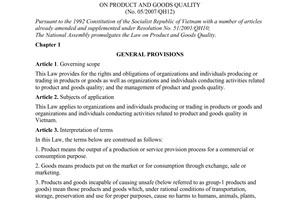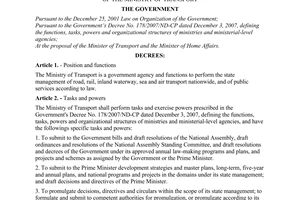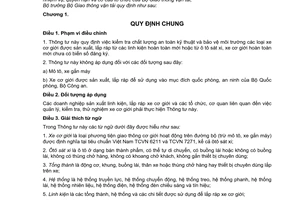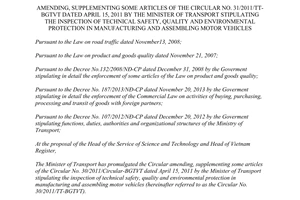Nội dung toàn văn Circular No. 30/2011/TT-BGTVT on the environment protection and technical safety
|
THE
MINISTRY OF TRANSPORT |
THE
SOCIALIST REPUBLIC OF VIETNAM |
|
No. 30/2011/TT-BGTVT |
Hanoi, April 15, 2011 |
CIRCULAR
ON THE ENVIRONMENT PROTECTION AND TECHNICAL SAFETY QUALITY INSPECTION IN MOTOR VEHICLE PRODUCTION AND ASSEMBLY
Pursuant to the Law on Road traffic of November 13, 2008;
Pursuant to Law on Product and goods quality of November 21, 2007;
Pursuant to the Government's Decree No. 132/2008/NĐ-CP of December 31, 2008 on detailing the implementation of a number of articles of Law on Product and goods quality;
Pursuant to the Government's Decree No. 51/2008/NĐ-CP of April 22, 2008 on defining the functions, tasks, powers and organizational structure of the Ministry of Transport;
The Minister of Transport prescribes as follows:
Chapter 1.
GENERAL PROVISIONS
Article 1. Scope of regulation
1. This Circular prescribes the environment protection and technical safety quality inspection of motor vehicles produced and assembled from brand-new parts or from car chassis, brand-new motor vehicles without license plates.
2. This Circular is not applicable to the following objects:
a) Motorcycles
b) Motor vehicles produced, assembled for National defense and security purposes of the Ministry of National Defense and the Ministry of Public Security.
Article 2. Subjects of application
Enterprises producing parts, assembling motor vehicles and organizations, agencies relating to the motor vehicle management, inspection and test must implement this Circular.
Article 3. Interpretation of terms
The terms in this Circular are construed as follows:
1. Motor vehicles are motorized means of transport traveling on road (except for motorcycles) defined in the Vietnam Standard TCVN 6211 and TCVN 7271, including car chassis;
2. Car chassis are unfinished cars able to move itself, having or not having the cabin, not having the cargo container, not being attached specialized equipment;
3. Parts are the engine, chassis, cabin, body, cargo container or specialized equipment attached to the vehicle;
4. Systems are the transmission system, dynamic system, suspension system, brake system, steering system, fuel system, electric system, light and signal system;
5. Components are parts, systems and pieces used for motor vehicle assembly;
6. Products are components or motor vehicles;
7. Products of the same type are products with the same features as prescribed in Annex I promulgated together with this Circular;
8. Product type certification is the process of inspecting, testing, considering, assessing and certifying the conformity of one type of products to the technical regulations, standards and current provisions of the Ministry of Transport on the technical safety quality and environment protection;
9. Typical samples are products selected by the producing facility to perform inspections and tests;
10. Producing facilities are qualified enterprises that produce components, assemble motor vehicles under the current provisions;
11. Designing facilities are organizations that operate motor vehicle design services under the current provisions;
12. The Quality control agency is the Vietnam Register affiliated to the Ministry of Transport;
13. Testing facilities are domestic or foreign organizations and individuals that perform tests for components or motor vehicles and have been assessed and accredited by quality control agencies;
14. Technically defective products are products containing defects during the design, production, assembly that possibly endanger the users’ lives and property as well as negatively affect the community’s environment and safety;
15. Product recall is the act by producing facilities dealing with the products belonging to the defective types or lots that have been supplied to the market aiming to repair, replace spare parts or replace with other products in order to prevent potential dangers caused by the defects in design, production, assembly.
Chapter 2.
PROVISIONS ON ENVIRONMENT PROTECTION AND TECHNICAL SAFETY QUALITY INSPECTION
Article 4. Design dossier
1. The motor vehicle design dossier includes:
a) The explanation of motor vehicle technical design (original copy) as prescribed in section A of Annex II promulgated together with this Circular;
b) The technical drawing (original copy) as prescribed in section B of Annex II promulgated together with this Circular;
c. The sheet of specification and technical features of the parts, import system relating to the design and calculation contents (the authenticated copy of the photocopy verified by the designing facility).
2. Design dossier exemption: For motor vehicles produced and assembled under the foreign trademarks and designs, producing facilities are exempted from making design dossiers when providing the following substitute documents:
a) The drawing of product general arrangement;
b) The photocopy verified by the producing facility of the certificate issued by foreign competent agencies to the types of products;
c) The written certification from the technology transferring party on the conformity of the quality of products produced and assembled in Vietnam to the prototype.
Article 5. Design appraisal
1. Motor vehicle design dossiers must be appraised by quality control agencies.
2. Design appraisal is the examination, inspection and comparison of the product design dossier contents to the technical standards, regulation and current provisions of the Ministry of Transport on motor vehicles in order to ensure that all the products are produced and assembled consistently with the requirements for technical safety quality and environment protection.
3. For qualified design dossiers, quality control agencies shall issue the design appraisal certificate under the form prescribed in Annex III promulgated together with this Circular.
4. After being issued with the design appraisal certificate, one (01) design dossier shall be transferred to each of the following agencies and organizations: designing facilities , producing facilities and shall be archived in quality control agencies.
5. Amending and supplementing design dossiers
a) In case of amending and supplementing the appraised design dossiers, facilities producing or designing such products must send the supplemented and amended design dossiers and the written request to quality control agencies for appraising those amendments and supplements.
b) Designing facilities must make new design dossiers if the amendment and supplement fail to satisfy the requirements for products of the same type prescribed in Annex I promulgated together with this Circular.
6. Procedures for design appraisal
a) Order of implementation:
- Designing facilities , producing facilities (qualified for designing the products themselves) shall make 01 dossier on requesting design appraisal as prescribed and send to the Vietnam Register directly or through the postal system.
- The Vietnam Register shall receive, inspect the dossier composition, guiding the facilities to complete the incomplete dossiers and issue the appointment note for the time of giving design appraisal results.
- The Vietnam Register shall appraise the design dossiers, notify of the supplements and amendments for unqualified dossiers and issue the design appraisal certificates for qualified dossiers
b) Method of implementation:
Facilities shall submit the application dossiers on design appraisal and receive the results directly at the Vietnam Register or through the postal system.
c) The application dossier on design appraisal includes:
- 01 written request for design appraisal (original copy);
- 03 design dossiers (as prescribed in clause 1 Article 4);
- 01 Business registration certificate of the designing facility (for the first design appraisal of the designing facility) specifying that the enterprise is functioning motor vehicle design practice (the authenticated copy or the photocopy verified by the designing facility).
d) Time limit for handling:
The time limit for appraising design dossiers and issuing design appraisal certificates: within 15 days as from fully receiving the dossiers as prescribed.
Article 6. Testing typical samples
1. The items and objects required to be inspected and tested are prescribed in the Annex IV promulgated together with this Circular.
2. Testing facilities shall test the typical samples under the technical regulations, standards and current provisions of the Ministry of Transport on motor vehicles; make reports on test results and bear responsibilities for their test results. If necessary, quality control agencies may directly supervise the tests.
Article 7. Dossier on product inspection
1. The dossier of component inspection (belonging to the objects required to be tested prescribed in Annex IV promulgated together with this Circular) includes:
a) The report on the component inspection results;
b) The technical drawing attached with the product specification;
c) The product photograph, the explanation sheet of symbols and numbers written on the product (if any);
d) The description sheet of the technological process of production and the process of product quality inspection.
2. The dossier on motor vehicle inspection includes:
a) The reports on the test results of technical safety quality and environment protection under the technical regulations and standards, current provisions of the Ministry of Transport on motor vehicles.
b) The design dossier appraised by quality control agencies or the substitute documents prescribed in clause 2 Article 4 of this Circular;
c) The design photograph, the registration sheet of technical specification under the form prescribed in Annex V promulgated together with this Circular;
d) The statistics sheet of parts, domestic and imported production systems used for producing and assembling under the form prescribed in Annex VI promulgated together with this Circular;
dd) For imported components under the list of compulsory inspection prescribed in Annex IV promulgated together with this Circular, facilities producing and assembling motor vehicles must provide the photocopy verified by the producing facilities of one of the following documents:
- The written certification from foreign, domestic organizations on imported components being inspected under the mutual recognition agreements or conventions that Vietnam has signed;
- The certificate verified by foreign competent agencies in which certifying that the type of components has satisfied the corresponding ECE provisions of the UN;
- The report on test results of testing facilities in which certifying that the components have satisfied the current Vietnam’s technical regulations and standards.
e) The description sheet of the technological process of production, assembly, the process of product quality inspection;
g) The explanation sheet of the methods and positions where the engine and chassis ID numbers are carved;
h) The manual guide and warranty.
3. The dossier on product inspection must be archived at quality control agencies and producing facilities in at least 02 years as from the producing facility discontinues the production, assembly of the type of products that has been issued with the certificate.
Article 8. Assessing the conditions for quality inspection at producing facilities
1. In order to sustain the quality of mass-produced products, producing facilities need to perform the following tasks:
a) Building the process and guiding the quality inspection for each type of products from input component quality control, quality inspection of each stage to warranty and maintenance inspection;
b) Equipping the inspection devices necessary for each production stage. The list of necessary equipment for performing quality inspection of finished motor vehicles is prescribed in Annex VII promulgated together with this Circular; annually, the operation of inspection equipment of finished product quality must be inspected and certified by quality control agencies;
c) Assigning technicians in charge of the finished product quality who have been issued with the inspection practice certificate conformable to the production and assembly by foreign producers or quality control agencies.
2. Quality control agencies shall assess the conditions for product quality inspection at producing facilities under the following methods:
a) The first assessment shall be performed when issuing the certificate as prescribed in Article 9 of this Circular;
b) Annual assessments shall be performed annually;
c) Irregular assessments shall be performed when the producing facilities exhibit signs of violations of the provisions on quality inspection or when the complaints against product quality are lodged.
The assessment of conditions for product quality inspection in producing facilities shall be performed under the standard ISO/TS 16949 “Specific requirements for quality control systems of enterprises producing and assembling motor vehicles and motor vehicle components”.
3. For similar types of products without primary changes in the inspection process, quality control agencies shall assess the conditions for quality inspection of the first type of products.
Article 9. Issuing the certificate of technical safety quality and environment protection
1. Quality control agencies shall base on the product inspection dossiers prescribed in Article 7 and the reports on assessment results of conditions for product quality inspection in producing facilities as prescribed in clause 2 Article 8 of this Circular to issue the certificate of technical safety quality and environment protection (hereinafter referred to as certificates) to the types of products under the corresponding designs prescribed in Annex VIII promulgated together with this Circular.
2. Procedures for issuing certificates:
- Producing facilities shall make product inspection dossiers as prescribed in Article 7 of this Circular and submit to the Vietnam Register directly or through the postal system.
- The Vietnam Register shall receive and inspect the product inspection dossier composition: guide producing facilities to supplement the incomplete dossiers, or unanimously decide the time and place for assessing the conditions for product quality inspection at producing facilities if the dossiers are complete as prescribed.
- The Vietnam Register shall inspect the dossier contents and assess the conditions for product quality inspection at producing facilities as prescribed in clause 2 Article 8 of this Circular and notify the producing facilities to complete the unqualified dossiers, or issue the Certificates if the dossiers are qualified.
b) Method of implementation:
Producing facilities shall submit the inspection dossiers and directly receive the results at the Vietnam Register or through the postal system;
c) The dossier composition and quantity:
01 product inspection dossier as prescribed in clause 1; clause 2 Article 7 of this Circular.
d) Time limit for handling:
The time limit for issuing certificates: within 05 days as from the date of completing the inspection dossier and receiving positive results of the assessment of conditions for quality inspection at the producing facility.
Article 10. Inspection during mass production and assembly
1. After the product is issued with the certificate, producing facilities shall begin the mass production, inspect the quality throughout the production and assembly, ensure that the technical regulations and standards are satisfied as certified the in product and typical sample inspection dossier.
2. Producing facilities are responsible for the origin and quality of finished products.
3. Each of the mass-produced products must undergo factory release inspections in one of the two forms of factory release inspections: under the supervision of quality control agencies or active factory release inspections:
a) Factory release inspection under the supervision of quality control agencies.
Quality control agencies shall provide the supervision of the factory release inspection (hereinafter referred to as supervision) at facilities producing and assembling motor vehicles for humans or motor vehicles assembled from separate components in the following cases:
- Facilities producing and assembling motor vehicles for the first time;
- Producing facilities of which the product quality is unstable. The product quality is considered as unstable if the ratio of the unqualified products that need re-supervision to the supervised total supervised products is:
+ Over 5% for the entire supervision, or
+ Over 10% for a random month within the supervision.
- Producing facilities violating the provisions on quality inspection but not subject to certificate revocation.
The supervision contents are prescribed in Annex IX promulgated together with this Circular. Each supervision term is 06 months (with finished products) or 500 products depending on the first factor to come.
After the supervision, if the product quality is stable and the provisions on quality inspection are complied with, the producing facility shall be allowed to apply active factory release inspections as prescribed in point b this clause.
b) Active factory release inspection
Producing facilities not subject to the supervision prescribed in point a this clause shall be allowed to perform active factory release inspections under the current provisions.
Quality control agencies may irregularly carry out inspections. If the inspection shows that the producing facility has committed violations of provisions on product quality inspection, such producing facility shall, depending on the extent of violations, have their certificate revoked or be subject to the supervision prescribed in point a this clause.
3. Release dossiers of motor vehicles
a) For motor vehicles issued with certificates and the reports on the inspection and supervision results of such vehicles are made, producing facilities shall be allocated the blank sheet of release quality inspection (under the form prescribed in Annex X promulgated together with this Circular) corresponding to the vehicle quantity.
Basing on the inspection results of each product, producing facilities shall issue release quality inspection sheets (hereinafter referred to as factory release notes) to motor vehicles. The factory release note must be signed and sealed by competent persons (directors, deputy directors or inferior officers authorized in writing by the producing facility’s head).
The factory release notes for motor vehicles stated above shall be used for motor vehicle registration.
b) Producing facilities are responsible to make and issue the following dossiers to each motor vehicle:
- The factory release note as prescribed in point a this clause;
- The manual guide containing the primary specifications of the vehicle and instructions on using the safety equipment on the vehicle
- The warranty sheet specifying the conditions for warranty and the addresses of warranty facilities.
c) Producing facilities are responsible to report and transmit data relating to finished vehicle inspection to quality control agencies.
Article 11. Revoking certificates
Certificate shall be invalidated and revoked in the following cases:
1. When the products no longer satisfy the current provisions, technical regulations and standards or the products are changed inconsistently with the issued certificate;
2. When the assessment results of conditions for product quality inspection show that the producing facility has seriously violated the provisions on product quality inspection and factory release note issue;
3. When producing facilities omit to recall the technically defective products as prescribed in Chapter III of this Circular.
Chapter 3.
PROVISIONS ON RECALLING TECHNICALLY DEFECTIVE PRODUCTS
Article 12. Products required to be recalled
Producing facilities must recall the produced, assembled products in the following cases:
1. Products committing violations of current provisions, technical regulations and standards mandatorily applicable to such products;
2. Products causing dangers to lives and property due to technical defects during the design and production;
3. Products not causing loss of lives and property but may cause dangers in certain conditions when being used.
Quality control agencies shall base on the current provisions, technical regulations and standards, the information and investigation results to consider and make decisions on compulsory product recalls
Article 13. Recalling products
1. For producing facilities:
When detecting technical defects of circulating products, producing facilities need to perform the following tasks:
a) Suspending the release of the products of the technically defective type of products;
b) Within 05 working days as from detecting the technical defects, producing facilities must notify the sales agents in writing and request to suspend the provision of products of the same type of products that are technically defective;
c) Within 10 working days as from detecting the technical defects, producing facilities must send written reports to quality control agencies on detailing the reasons for technical defects, remedial measures, the product quantity required to be recalled and particular recall plans;
d) Within 05 days as from the quality control agencies receive the plans on recalls, producing facilities shall be notified of the plan approval results. The product recalls must comply with the requirements of such notifications;
dd) Producing facilities must make reports at least every 03 months on the product recall under the plan;
e) Within 30 days as from the recall is done, producing facilities must send written reports on the recall results to quality control agencies;
g) Producing facilities shall incur all expenses relating to the product recall, including carriage.
2. For quality control agencies
When detecting technical defects of circulating products, quality control agencies need to perform the following tasks:
a) Requesting producing facilities to make reports on the information relating to technical defects;
b) Depending on the dangers and urgency of technical defects to make request in writing for remedial plans from producing facilities within 05 days;
c) Fully, promptly and objectively posting information about recalled products on the official websites of quality control agencies.
d) Monitoring the producing facilities’ implementation of the notified recall plans;
dd) Temporarily revoking certificates of technically defective products until the producing facilities release the product recall as prescribed. Within 03 months as from the last day of recall, if producing facilities omit to make reports on the recall completion, the certificates stated above shall be permanently revoked and implicitly invalidated.
Article 14. Responsibilities of relevant agencies, organizations and individuals
1. Producing facilities are responsible to:
a) Establish the quality control system and monitor the information about customers purchasing products to inform when necessary;
b) Establish the system of collecting information about product quality, analyze technical defects and archive relevant information;
c) Actively and fully report information relating to technical defects. Fully cooperate and provide necessary information when being requested during the investigation performed by quality control agencies;
d) Notify necessary information relating to the recall to the agents, service stations and customers;
dd) Recall the products in accordance with this Circular.
2. Organizations and individuals possessing the motor vehicles shall have the following rights and responsibilities:
a) Notifying the technical defects occurring during the use to producing facilities and quality control agencies;
b) Fully cooperate with quality control agencies during the inspections and facilitate the recalls of producing facilities as prescribed.
3, Quality control agencies are responsible to:
a) Guide the product recalls as prescribed in this Circular;
b) Compel the implementation of the provisions on product recall;
c) Accurately, sufficiently and equitably provide information about products required to be recalled at the request of competent agencies;
d) Temporarily or permanently revoke the certificates of the types of products required to be recalled.
Article 15. Other requirements
1. If necessary, quality control agencies may refer to experts to assess the danger of technical defects in order to make necessary decisions.
2. Quality control agencies are entitled to request producing facilities to pay the expenses relating to the inspection, test or examination of technically defective products as prescribed.
3. Producing facilities violating these provisions, depending on the violation extend, may be suspended or terminated the certification of all products.
Chapter 4.
EFFECTS
Article 16. Effects
1. This Circular takes effect after 45 days as from its signing and abolished the Decision No. 34/2005/QD-BGTVT of July 21, 2005 of the Minister of Transport.
2. The unexpired certificates, factory release notes issued before this Circular takes effect shall be still valid until their expiry.
Chapter 5.
ORGANIZING THE IMPLEMENTATION
Article 17. Responsibilities of quality control agencies
1. Guiding the inspection techniques basing on the assigned functions and tasks prescribed in this Circular;
2. Unanimously publishing, managing and guiding the use of certificates and factory release note blanks;
3. Informing the list of testing facilities performing the test of components and motor vehicles serving the certification of technical safety quality and environment protection;
4. Organizing periodic or irregular inspections of the quality inspection of producing facilities;
5. Organizing the inspection and test of imported components under the list of compulsory inspection and test prescribed in Annex IV promulgated together with this Circular on suspicion of the quality
6. Summing up the results of environment protection and technical safety quality inspection of motor vehicles to periodically report to the Ministry of Transport.
Article 18. Responsibilities of producing facilities
1. Building the quality control system in order to sustain the mass-produced product quality;
2. Fulfilling the responsibilities to recall the technically defective products as prescribed in this Circular;
3. Fully cooperating with inspecting agencies during the inspection of product quality.
Article 19. Fees and charges
Quality control agencies and testing facilities are entitled to collect the charges under the current provisions of the Ministry of Finance.
Article 20. Organizing the implementation
The Chief of the Ministry Offices, The ministerial Chief inspectors, the directors of Departments, the Director of the Vietnam Register, Heads of agencies, relevant organizations and individuals are responsible to implement this Circular.
|
|
THE
MINISTER |
------------------------------------------------------------------------------------------------------
This translation is made by LawSoft and
for reference purposes only. Its copyright is owned by LawSoft
and protected under Clause 2, Article 14 of the Law on Intellectual Property.Your comments are always welcomed





